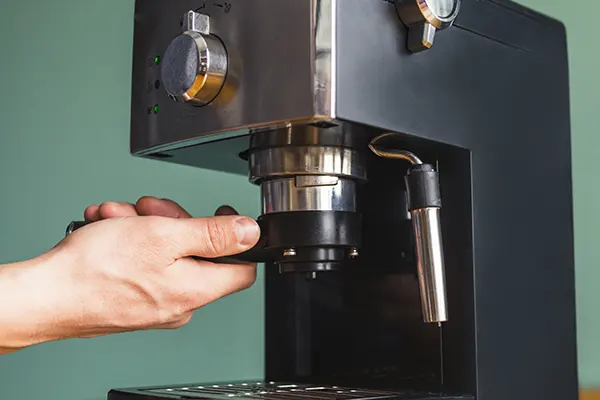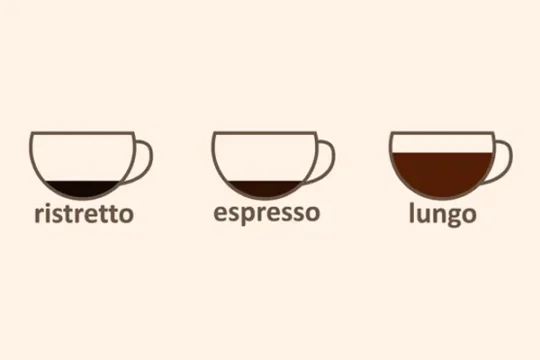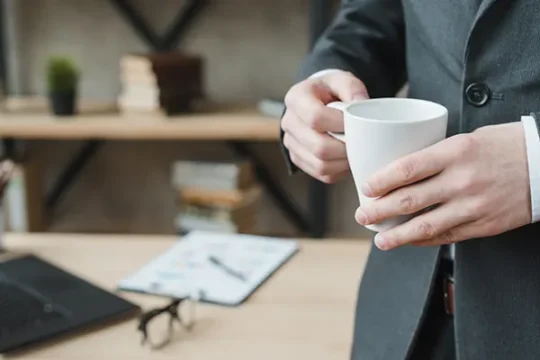TABLE OF CONTENTS
Espresso didn’t emerge from years of laboratory research or careful scientific planning. The truth involves a hotel owner in Italy who got fed up with slow coffee service. His solution—cobbled together in 1884—accidentally changed how the entire world drinks coffee.
Nobody planned for it to become this significant. It just happened because one person refused to accept that making coffee had to take forever.
Angelo Moriondo: The Original Inventor of Espresso
Turin, 1884. Angelo Moriondo ran two establishments—the Grand Hotel Ligure and a bar called the American Bar. Business was solid except for one persistent problem: coffee service was painfully slow. Traditional brewing took several minutes per pot. Customers would order, then wait. Some left. Others complained. Both outcomes cost money.
Moriondo decided to fix it himself. He built a machine using steam pressure to push hot water through coffee grounds. Brewing time dropped from several minutes down to seconds. Filed a patent in 1884. What mattered: the thing worked. Customers got coffee immediately. Complaints stopped. Revenue improved.
But here’s the puzzling part—Moriondo never sold the machine. Not one unit. Didn’t license it. Didn’t commercialize it at all. Just kept it for his own businesses and told nobody else about it.
How Moriondo’s Revolutionary Machine Worked
Nothing complicated about the design. Big boiler heated water. Steam pressure built up. Once pressure got high enough, it forced water through packed coffee grounds in a chamber. Basic physics applied to coffee service.
Volume capacity made it practical. Regular brewing meant one pot serving maybe five cups, then starting over. Moriondo’s machine handled multiple servings at once. Morning rush with thirty people wanting coffee? No longer a problem. Everyone got served quickly instead of the first customer getting fresh coffee while the last person in line got whatever had been sitting there cooling for twenty minutes.
Was it perfect? Not even close. Temperature fluctuated. Pressure wasn’t consistent. Some cups probably tasted better than others. But compared to the alternative—making everyone wait while brewing pot after pot—these issues seemed manageable. It solved the immediate business problem, which was the entire point.
Why He Kept His Invention Private
This decision still puzzles people. Moriondo had something valuable. Other hotel owners and café operators would’ve paid good money for machines that eliminated wait times and improved customer satisfaction. He could’ve made a fortune licensing the technology or manufacturing equipment for sale.
Instead, he kept everything locked down tight.
Why? Competition explains it. Turin had dozens of hotels, bars, cafés all fighting for the same customers. Most offered basically identical experiences. But Moriondo’s places had something nobody else could provide: instant coffee service. That’s a real competitive advantage.
Business travelers who’d stayed there before knew they could get coffee immediately at breakfast instead of waiting fifteen minutes while staff brewed multiple pots. That matters when you’re trying to catch a train or get to meetings.
Moriondo apparently calculated that keeping the technology exclusive generated more value than whatever he’d make selling machines. Debatable strategy. Could’ve made more money commercializing it. But his businesses thrived, so the decision worked for his specific situation.
The Lasting Impact of the 1884 Patent
Keeping machines private didn’t make the invention disappear. Patents get filed publicly. Other inventors accessed the documents, studied what Moriondo had done, understood the principles involved.
Moriondo’s machine had problems. Lots of them. By today’s standards, it was primitive. But that misses what actually mattered. He proved you could use pressure to force water through coffee grounds and get better results than traditional methods. That’s the insight that changed everything for the history of espresso.
Once that concept was established, other people could build on it. Fix the temperature control issues. Stabilize the pressure. Scale it properly. All those improvements came later. Moriondo just showed the approach worked.
Sometimes that’s more valuable than getting every detail right initially. His patent became the foundation everyone else built on, whether he intended that or not.
Luigi Bezzera: Refining and Commercializing the Concept
Milan, 1901. Luigi Bezzera owned a factory. His workers took coffee breaks that lasted too long—not because they were lazy, but because making coffee took forever. In a manufacturing environment, that idle time adds up fast. Less productivity means less output means lower profits.
Bezzera got hold of Moriondo’s patent and saw ways to improve it. His machine had individual brew heads. Major upgrade. Instead of brewing big batches, you could make single servings on demand. Each cup fresh.
He also invented the portafilter—that handled basket thing baristas use to hold grounds. These changes gave much better control over each serving.
People started calling it “caffè espresso,” which translates roughly to coffee made expressly for you. Made specifically for that person right then, not poured from some batch sitting around getting stale.
Bezzera also fixed a bunch of mechanical problems that made Moriondo’s design unreliable. Temperature became more stable. Pressure more consistent. These aren’t exciting improvements to discuss, but they’re what separate a prototype from equipment you can actually depend on day after day in busy commercial settings.
Desiderio Pavoni: The Marketing Genius Behind Espresso’s Success
Bezzera could invent things. Marketing them? That wasn’t his strength. In 1903, Desiderio Pavoni bought the patent rights and started manufacturing under the La Pavoni brand.
More importantly, Pavoni understood something critical: having great technology doesn’t matter if you can’t convince people to buy it.
Milan Fair, 1906. Pavoni’s breakthrough moment. He brought espresso machines to the fair and ran live demonstrations. Let café owners see equipment work. Taste the coffee. Watch how fast it was. Response was immediate and overwhelming.
Within a few years, La Pavoni machines became standard in Italian cafés everywhere. Espresso went from interesting novelty to essential equipment.
What made Pavoni successful was understanding his customers. He didn’t talk about technical specifications or engineering details. He talked about business outcomes café owners cared about: serving more customers per hour, reducing wait times, improving coffee quality, increasing revenue.
He had testimonials from other café owners already seeing those results. Made the return on investment obvious.
That’s how you sell commercial equipment—not by listing features, but by demonstrating how it solves real operational problems and improves bottom lines.
By the time competitors figured out what was happening, Pavoni had already captured the market. He didn’t just sell machines. He created demand for an entirely new category of equipment that cafés suddenly couldn’t operate without.
Achille Gaggia and the Birth of Modern Espresso
Steam-powered espresso machines had been around for decades by 1938. They worked fine, but had a hard limit. Steam pressure topped out around 2 bars. That was just physics—you couldn’t get more pressure from steam without the whole thing becoming dangerous.
Achille Gaggia decided that limit wasn’t acceptable and designed something completely different using a spring-loaded lever with a piston.
His machines hit about 9 bars of pressure. That extra force changed everything about extraction. More flavor compounds got pulled from beans. But something unexpected happened too: crema.
That golden foam layer on top of espresso didn’t exist before Gaggia. His higher pressure created it for the first time. Almost immediately, crema became the standard for judging espresso quality. No crema meant something went wrong with the shot.
Pretty much everything about modern espresso standards traces back to Gaggia. The 9-bar pressure benchmark? His number. Checking for crema? His legacy. Even saying you’re “pulling” a shot comes from his lever machines where baristas literally pulled down a lever to brew each cup.
Most machines now are automatic, but we still use that language.
The history of espresso had several important developments before Gaggia showed up, but his contribution might be the most lasting. He didn’t just improve the process. He defined what quality espresso should be, and the industry still follows that definition.
From Italian Tradition to Global Coffee Culture
Espresso stayed mostly Italian for a long time. Other countries knew about it—you could maybe find it in Italian restaurants or specialty shops—but it wasn’t mainstream.
That started changing after World War II. Italian families immigrated to new countries and brought their coffee culture along. American soldiers who’d been stationed in Italy came home wanting the espresso they’d gotten used to overseas.
Some espresso bars opened up in the 1950s and 60s. Mostly in cities, usually in neighborhoods with big Italian populations. But it remained pretty niche. Most people still drank drip coffee or instant coffee. Espresso was this exotic Italian specialty thing.
The real explosion didn’t happen until the 1980s and 90s with the specialty coffee movement. That’s when consumers started actually caring about coffee quality—where beans came from, how they were roasted, preparation methods. Coffee transformed from a commodity into an experience people paid attention to.
Now espresso is everywhere. Office breakrooms have machines. Cafés build entire menus around it. The technology has obviously advanced massively from Moriondo’s steam-powered contraption in 1884. Modern equipment is precise, programmable, often fully automated.
But strip away all that advancement and the core principle is identical: use pressure to force hot water through ground coffee and extract a concentrated shot.
What started as one business owner’s fix for a specific operational problem became fundamental to global coffee culture. Nobody set out to change the world. Moriondo just wanted faster service in his hotel.
But that’s how many important innovations happen—someone solves an immediate practical challenge and accidentally creates something much bigger. The history of espresso is really a case study in how addressing straightforward business problems can reshape entire industries and cultural practices worldwide.
Quality Coffee Solutions for Modern Workplaces
Office coffee service matters more than most companies realize. Employee satisfaction, productivity, company culture—quality coffee impacts all of it. The same principles that drove Moriondo’s innovation in 1884 still apply: businesses need reliable solutions that address real operational needs.
Wake Up Coffee works with organizations throughout Kitchener, Waterloo, Cambridge, and the GTA providing comprehensive coffee services. Bean-to-cup machines grinding fresh for every cup. Quality beans from ethical sources in Brazil, Colombia, and Central America. Dependable maintenance and support.
If your current setup isn’t meeting standards, let’s talk about what’s possible. Visit our <a href=”https://wakeupcoffee.ca/office-coffee-service/”>office coffee service</a> page and we’ll discuss options that make sense for your workplace.
Your team deserves coffee that reflects the innovation and quality standards that have defined specialty coffee for over a century. Contact us today to explore better solutions.





